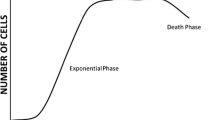Abstract
The evolution of basal synthetic formulations to support mammalian cell culture applications has been facilitated by the contributions of many investigators. Definition of minimally-required nutrient categories by Harry Eagle in the 1950's spawned an iterative process of continuous modification and refinement of the exogenous environment to cultivate new cell types and to support emerging applications of cultured mammalian cells. Key historical elements are traced, leading to the development of high potency, basal nutrient formulations capable of sustaining serum-free proliferation and biological production. Emerging techniques for alimentation of fed batch and continuous perfusion bioreactors, using partial nutrient concentrates deduced from spent medium analysis, can enhance medium utilization and bioreactor productivity.
Similar content being viewed by others
References
Barnes D and Sato G (1980) Serum-free Cell Culture: A Unifying Approach. Cell 22: 649.
Bibila TA, Ranucci CS, Glazomitsky K, Buckland BC and Aunins JG (1994) Monoclonal Antibody Process Development using Medium Concentrates. Biotechnol Prog 10: 87–96.
Bottenstein J, Hayashi I, Hutchings S, Masui H, Mather J, McClure D, Ohasa S, Rizzino A, Sato G, Serrero G, Wolfe R and Wu R (1979) The Growth of Cells in Serum-Free Hormone Supplemented Media in WB Jakoby and IH Pastan (eds), Methods in Enzymology, vol. 58, pp. 94–109, Academic (New York).
Dulbecco R and Freeman G (1959) Plaque Production by the Polyoma Virus. Virology 8: 396–397.
Eagle H (1955) Nutrition Needs of Mammalian Cells in Tissue Culture. Science 122: 501–504
Eagle H (1959) Amino Acid Metabolism in Mammalian Cell Cultures. Science 130: 432–437.
Fike R, Kubiak J, Price P and Jayme D (1993) Feeding Strategies for Enhanced Hybridoma Productivity: Automated Concentrate Supplementation. BioPharm 6: 49–54.
Gruber DF and Jayme DW (1994) Cell and Tissue Culture Media: History and Terminology, in Cell Biology: A Laboratory Handbook, vol. 3, pp. 451–458, Academic (New York). Ham RG (1982) Importance of the Basal Nutrient Medium in the Design of Hormonally Defined Media, in Growth of Cells in Hormonally Defined Media, vol. 9A, pp. 39–60, Cold Spring Harbor Conferences on Cell Proliferation.
Ham RG (1965) Clonal Growth of Mammalian Cells in a Chemically-Defined, Synthetic Medium. Proc Natl Acad Sci USA 53: 288–293.
Ham RG (1984) Formulation of Basal Nutrition Media, in DW Barnes, DA Sirbasku and GH Sato (eds.) Methods for Preparation of Media, Supplements, and Substrata for Serum-Free Animal Cell Culture, Cell Culture Methods for Molecular and Cell Biology, vol. 1, Liss (New York).
Iscove NN (1984) Culture of Lymphocytes and Haemopoietic Cells in Serum-Free Medium in DW Barnes, DA Sirbasku and GH Sato (eds.), Methods for Preparation of Media, Supplements, and Substrata for Serum-Free Animal Cell Culture, Cell Culture Methods for Molecular and Cell Biology, vol. 1, Liss (New York).
Jayme DW and Blackman KE (1985) Culture Media for Propagation of Mammalian Cells, Viruses, and Other Biologicals, in Advances in Biotechnological Processes, vol. 5, pp. 1–30, Liss (New York).
Jayme DW and Greenwald DJ (1991) Media Selection and Design: Wise Choices and Common Mistakes. Bio/Technology 9: 716–721.
Jayme DW (1991) Nutrient Optimization for High Density Biological Production Applications. Cytotechnology 5: 15–30.
Jayme DW and Gruber DF (1994) Development of Serum-Free Media and Methods for Optimization of Nutrient Composition, in Cell Biology: A Laboratory Handbook, vol. 1, pp. 18–24, Academic (New York).
Jayme DW, Kubiak JM and Fike RM (1995), 'Productivity Enhancement Using Liquid Medium Concentrates', in EC Beuvery, JB Griffiths and WP Zeijlemaker (eds.), Animal Cell Technology: Developments Toward the 21st Century, Kluwer, pp. 199–204.
Mahadevan MD, Klimkowsky JA and Deo YM (1994) Media Replenishment: A Tool for the Analysis of High-Cell Density Perfusion Systems. Cytotechnology 14: 89–96.
Moore GE, Gerner R and Franklin H (1967) Culture of Normal Human Lymphocytes. J Amer Med Assoc 199: 519–524.
Murakami H, Masui H, Sato GH, Sueoka N, Chow TP and Kono-Sueoka T (1982) Growth of Hybridoma Cells in Serum-Free Medium: Ethanolamine is an Essential Component. Proc Natl Acad Sci USA 79: 1158–1162.
Murakami H, Shimomura T, Nakamura T, Ohashi H, Shinohara K and Omura H (1984) Development of a Basal Medium for Serum-Free Cultivation of Hybridoma Cells in High Density. J Agricult Chem Soc Japan 56: 575–583.
Murakami H, Hasizume S, Ohashi H, Shinohara K, Yasumoto K, Nomoto K and Omura H (1985) Human-Human Hybridomas Secreting Antibodies Specific to Human Lung Carcinoma. In Vitro Cell. Devel Biol 21: 593–596.
Murakami H and Yamada K (1987) Production of Cancer-specific Monoclonal Antibodies with Human-Human Hybridomas and their Serum-free, High-density, Perfusion Culture in RE Spier and JB Griffiths (eds.), Modern Approaches to Animal Cell Technology, chapter 4, pp. 52–76, Butterworths (London).
Murakami H (1989) Serum-Free Media Used for Cultivation of Hybridomas in Monoclonal Antibodies: Production and Application, pp. 107–141, Liss (New York).
Roth G, Kubiak JM, Long JF and Schoofs GM (1995) An Automated System to Produce Cell Culture Media from Liquid Medium Concentrates. BioPharm 8: 31–35.
Waymouth C (1984) Preparation and Use of Serum-Free Culture Media, in DW Barnes, DA Sirbasku and GH Sato (eds.), Methods for Preparation of Media, Supplements, and Substrata for Serum-Free Animal Cell Culture, Cell Culture Methods for Molecular and Cell Biology, vol. 1, Liss (New York).
Author information
Authors and Affiliations
Rights and permissions
About this article
Cite this article
Jayme, D., Watanabe, T. & Shimada, T. Basal medium development for serum-free culture: a historical perspective. Cytotechnology 23, 95–101 (1997). https://doi.org/10.1023/A:1007967602484
Issue Date:
DOI: https://doi.org/10.1023/A:1007967602484




